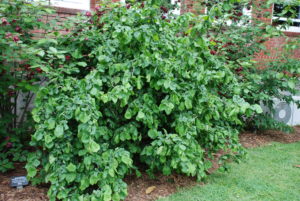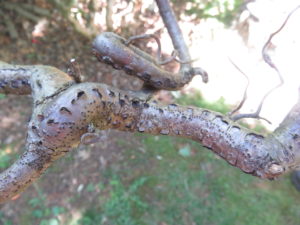European Hazelnut (Corylus avellana) is highly prized both for its edible nuts and as a landscape shrub/small tree. Unfortunately, it is susceptible to eastern filbert blight (EFB). American hazelnut (C. americana) is relatively resistant.
EFB is a lethal disease as it may kill a large shrub in 4-5 years. The fungus was discovered in the Pacific northwest on commercial hazelnut trees and contorted filbert, var. ‘Contorta’, aka ‘Harry Lauder’s Walking Stick’, a popular landscape shrub (USDA hardiness zones 4-8). EFB is also prevalent in the eastern U.S.
Canker sores (elliptical black stromata) are the key symptoms. Susceptible trees with many cankers must be removed as soon as possible. On American hazelnut small cankers will form on its branches, but do not lead to an extensive dieback as observed on European species.
The fungus disease emerges in spring as a milky ooze and is carried by wind-driven rain and splashing raindrops to other branches and to nearby trees. The fungus invades the phloem and outermost layers of xylem. The cankers appear on the surface of the branch 12-18 months later. Infection worsens during long periods of high humidity and occurs over a wide range of temperatures.
Inspect shrubs in winter for cankers and in July and August for dead or dying branches. Infected branches should be pruned 18 inches past the canker. All cut branches should be burned or removed from the property. Treat with chlorothalonil fungicide (such as Daconil, other brands) at spring bud break and every two weeks through the spring season.
European hazelnuts are valued for their highly prized nuts. Native hazelnuts do not produce high quality nuts, but are valued as a wildlife food source. European hazelnut orchards are produced primarily in the Pacific Northwest.
‘Red Dragon’, a red leaf cultivar of C. avellana ‘Contorta’, is resistant to eastern filbert blight. It grows 5-8 feet tall and 8-10 feet wide (USDA hardiness zones 4-8).



 Posted in
Posted in 
